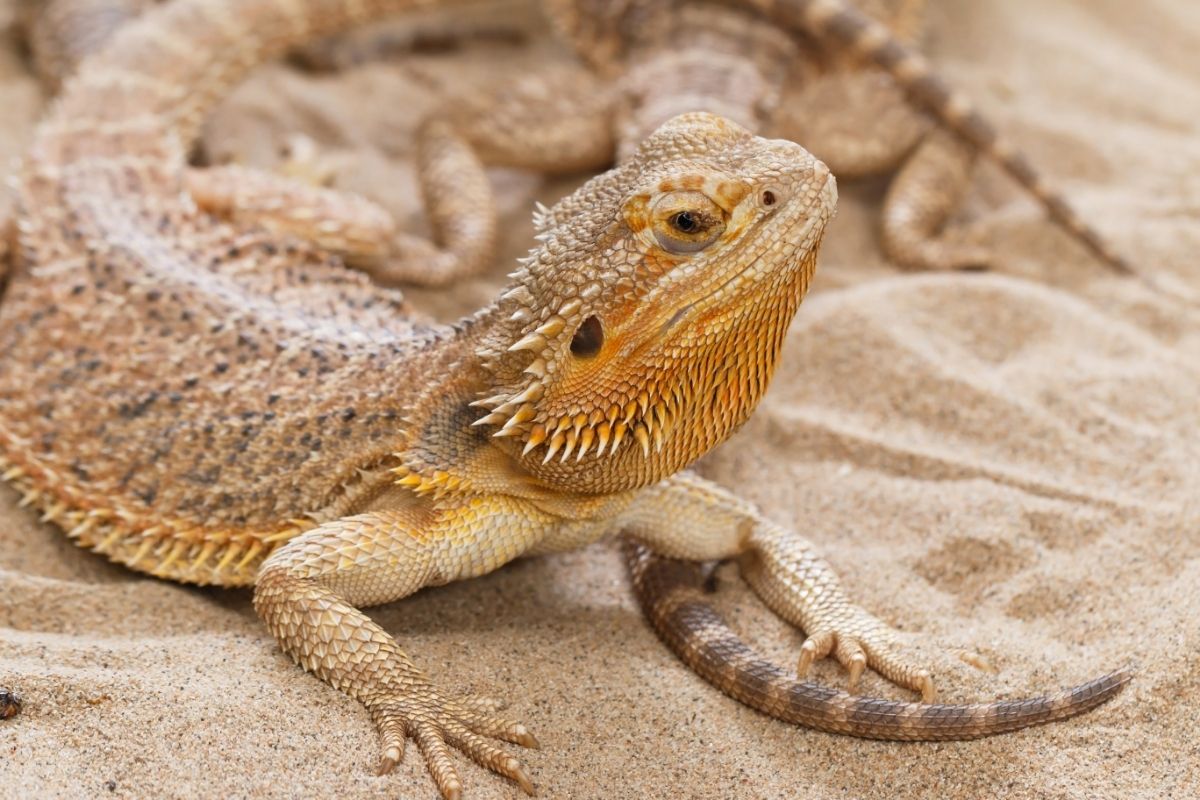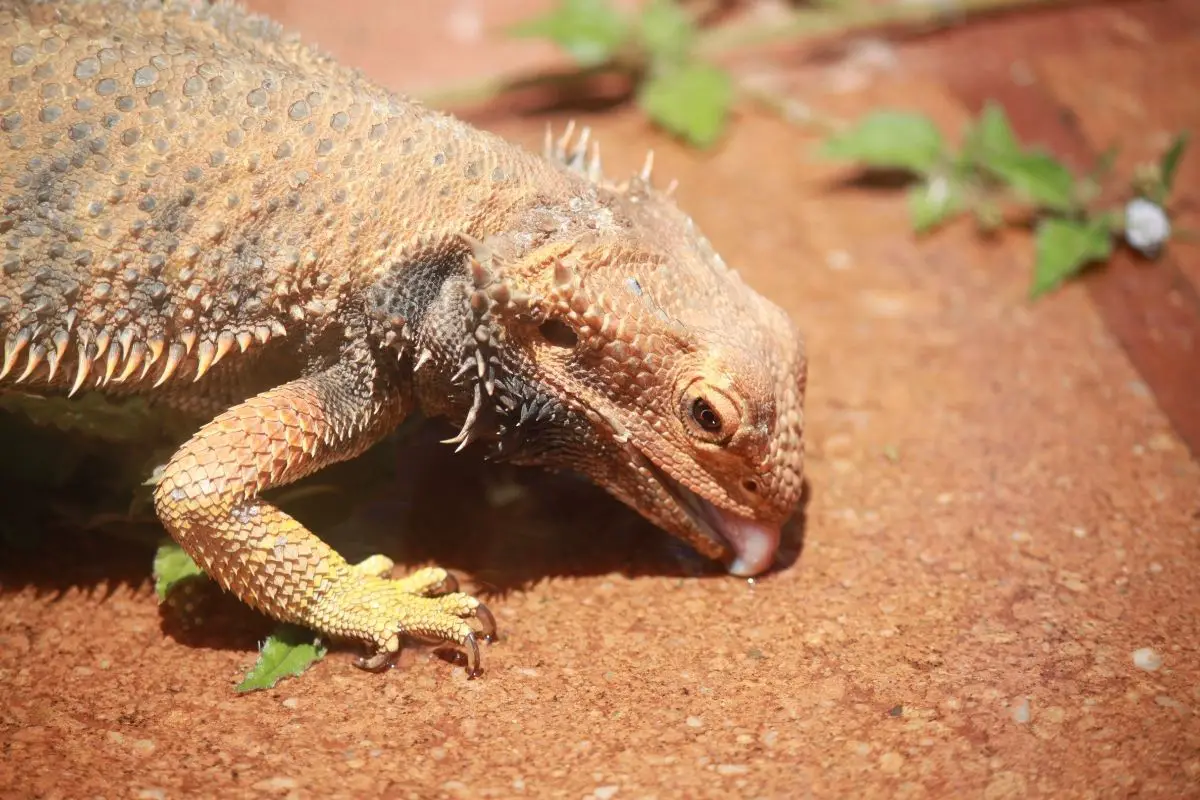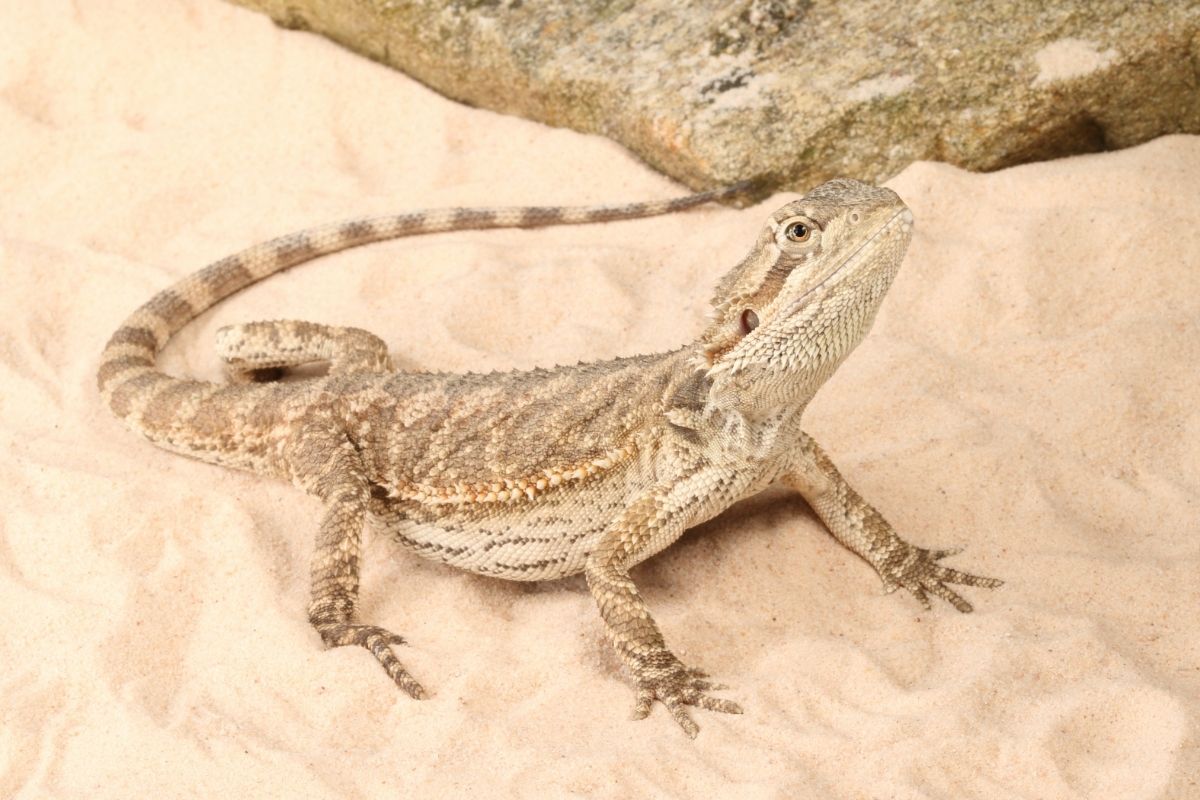When you are considering a habitat for your bearded dragon, you may not want to go all out and spend too much money on something expensive that they may not enjoy.
A lot of people use reptile carpet or newspaper as substrate, yet you may be wondering if sand is bad for bearded dragons.

How sand measures up as a substrate to other materials is something you should pay attention to, as it can be used but only after taking certain measures.
Sand can be relatively inexpensive, yet the main concern is what may happen if your bearded dragon consumes and ingests it.
Any detrimental effects on their health can be prevented relatively easily, and it may simply depend on the type of sand you use and what you use with it.
In this guide, we will look at how sand can be acceptable to use as a substrate for your bearded dragon.
We will also look at the steps you can take to ensure that the sand is ok in their habitat, why wild bearded dragons fail to be impacted by eating sand, and the other types of substrate you can use.
Why People Disagree Over Using Sand As A Substrate
From breeders to owners to veterinarians. Few can quite agree on what substrate is ideal for a bearded dragon.
Sand is a common cause for their disagreement as so many people believe it is ideal while others heartily disagree and favor another substance.
The argument largely rests on the impact of eating sand and the problems that can cause.
Different types of sand and different scenarios affect the health of a bearded dragon.
For instance, beach sand has been suggested as a more natural substrate, yet this is not recommended.
While sand may feel good for a human, it can contain minuscule pieces of glass and other non-organic materials that, when consumed, can injure your bearded dragon.
That is not to mention the bacterial content as well as several pathogens that may be lurking in the beach sand that you cannot see and may not be aware of until it is too late.
Do not be tempted to fill a few jars of beach sand and expect it to be an ideal substrate for your bearded dragon, as you may find that their health soon suffers.
You may be able to buy beach sand commercially, which can be an option.
However, this type of sand has to be sifted and then heat sterilized to ensure it is safe to use for a bearded dragon, so check with the manufacturer first.
Why Sand Can Be Ok For Your Bearded Dragon
In some cases, sand may be bad for your bearded dragon, or it could be ok. It depends on how it is used.
Of course, eating an excessive amount of sand can have an impact, yet there is a reason why a bearded dragon eats sand in the first place.
This is due to the requirement of calcium for their growth as well as maintaining their bones.
Bearded dragons typically eat dirt in the wild as a source of calcium which is the underlying reason why they eat sand, as an attempt to balance out their mineral intake.
There are measures you can take to prevent this from happening.
If you provide enough calcium for their diet, then the bearded dragon will not be tempted to eat the sand.
A failure to provide a sufficient amount of calcium will likely result in an impact from the eating of sand as their natural behavior will take over, and the sand is the only viable option that they have.
This can be a major problem for a captive bearded dragon yet fails to have such an impact on a wild one.
There is also a very simple precaution you can take with any sand to mitigate the risk that it could have on your bearded dragon.
By sifting the sand through a truly fine sieve, you can remove any large particles so you can guarantee it is soft but this can be a time-consuming process.
You also need to be extra careful with a young bearded dragon as their digestive system is not yet fully developed and will be smaller than an adult’s.
Any large particles can get stuck when ingested so avoid any particulate substrates.
The Reason Why Wild Bearded Dragons Are Not Impacted By Eating Sand

You could have read that bearded dragons live in the desert, but this is not strictly true.
Specifically, they come from Australia’s dry woodlands, which do not contain much sand.
They may appear to be eating the sand yet the dirt from the ground in Australia does contain the required minerals that they need.
The sand used in the habitat of a bearded dragon is not the same and does not contain the minerals, such as calcium, that the creature needs.
This is largely why you may see your bearded dragon eating the sand in an attempt to receive more calcium, as this is their natural behavior.
It may work in the wild with different sand, yet in captivity; it can be harmful.
How You Can Ensure That Sand Is OK For Your Bearded Dragon
Your bearded dragon will be tempted to eat the sand, no matter what.
Changing the substrate away from sand may be tempting yet you should stick with it as opposed to the newspaper, kitchen roll, or reptile carpet.
One simple reason why is that it looks authentic as their natural habitat.
Another reason is that a bearded dragon simply adores digging as one of their natural behaviors.
They can bury themselves in the sand, dig themselves a cave, then hide and sleep in it.
Denying them the sand to perform these intrinsically natural activities is to stop them from being themselves.
They should have sand in their natural habitat, yet to make sure they can do it safely means ensuring enough calcium is made available to them consistently.
You can do this by offering additional calcium to their food bowl. Furthermore, you could dust their feeder insects with calcium, so they ingest it anyway.
If you do opt for the food bowl option, then use sepia as it can be shredded, and the bearded dragon can take some when they want, whereas calcium powder may be of too fine a consistency.
As long as there is calcium available, you should not be too worried if you see your bearded dragon eat any sand.
The same reasoning applies to juvenile bearded dragons, as they may suffer from poor aim when feeding and accidentally take in some sand.
This does improve, yet when they are a baby, a lot of owners worry about the sand’s impact and insist on newspapers while they are growing up.
Again, if a sufficient amount of calcium is made available, then you can still keep your juvenile bearded dragon on the sand.
Of course, they may still eat the odd bit of sand, but with calcium being made available, they should not be tempted to seek it out by eating the sand.
You may also be tempted to invest in some calcium sand as a catch-all solution to the problem by providing calcium and sand at the same time.
However, a bearded dragon can still eat too much of this substance and then still get impacted.
The easiest way to ensure that a bearded dragon does not eat too much sand is to provide enough calcium.
In this case, use regular sand but have a bowl of sepia available at all times, so the creature is not tempted to eat the sand.
Types Of Substrates That May Be Ideal for Your Bearded Dragon

Knowing the necessity for adding calcium, you may be tempted to use calcium sand.
However, your bearded dragon may still eat an excessive amount of it and then be impacted by the results.
There are other alternatives to ensure that the substrate is substantial enough and that you can provide a sufficient intake of calcium.
Children’s Play Sand
You can use children’s play sand for a substrate though you may have to shop around as it will not be available in a pet store.
If you do choose this as an option, then ensure that the play sand is pesticide-free and that you mix it in with clay.
This is not just to provide some different textures, but if you do strictly use sand as a substrate, then it can cause trouble for the joints of your bearded dragon over time.
Only a small amount of clay is required, and a ratio of 1:5 with the sand would be ideal.
This is to make sure that your bearded dragon can still dig, but the clay will make the substrate a firm enough design to prevent it from sinking in as it would with a substrate wholly made from sand.
Burrowing Clay
If you do opt for burrowing clay, then make sure you can construct caves and hills with it. The clay should also be relatively simple to clean and mix in.
Anything you add to a bearded dragon’s habitat should look natural too.
Final Thoughts
When you are considering a substrate for your bearded dragon, then sand may seem ideal.
In a lot of cases, it is, but only if the sand has been sifted to get rid of any large particles and it is heat sterilized.
This means you should not use beach sand and if you do use sand, ensure you have calcium available, which is a crucial element in their growth and for maintaining their bones.
Without the calcium, the bearded dragon will be tempted to eat the sand in their search for minerals which can be incredibly problematic.
Frequently Asked Questions
When Can I Put Sand In My Bearded Dragon’s Tank?
If you have decided to use sand as the substrate for your bearded dragon, then wait until they have become a full adult.
This should occur when they are between one and a half to two years old.
Even then, at that age, you should only use play sand and ensure that it is cleaned and well-sifted.
Unless it is wholly clean, you run the risk of harboring bacteria which is prevented when you use a solid substrate.
What Is The Best Loose Substrate For My Bearded Dragon?
There are so many substrates out there that you may wonder which can be considered the best.
One that you may not have thought of is Alfalfa pellets which are an excellent loose substrate that is typically used as feed for horses and rabbits.
When layered, it can be an ideal loose substrate for pet lizards such as a bearded dragon as they can eat the pellets and will be safely digested.
Is It True That Bearded Dragons Need A Bed?
Yes, a lot of bearded dragons need a suitable environment to rest in and a bed, as they require more sleep than you may think.
This amount of sleep can be between eight and 12 hours so you should ensure that the conditions are right for them to get some slumber.
Your bearded dragon may be used to sleeping in the dark so you should make sure that little light can get into the environment such as the room that the cage is kept in.
As long as it is as dark as possible for those hours when you expect it to sleep, then you should get a well-rested bearded dragon.
